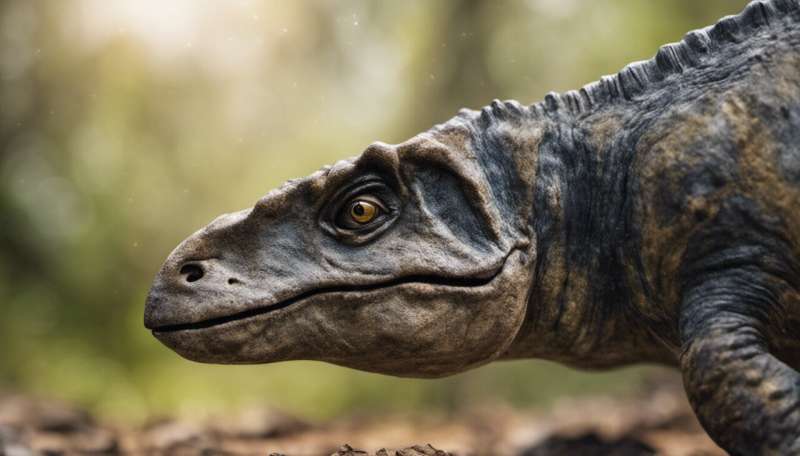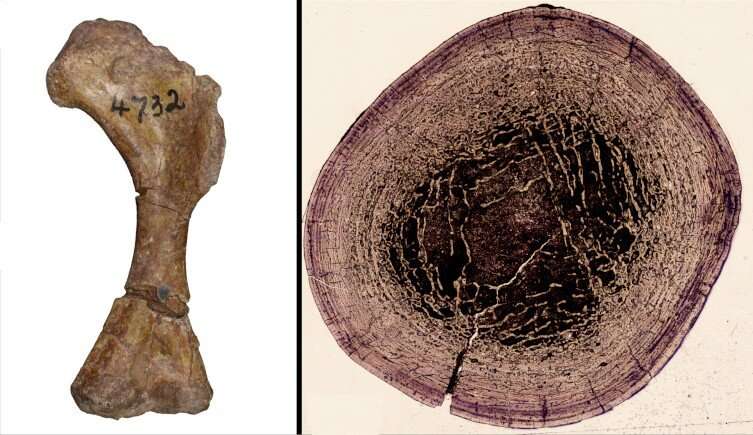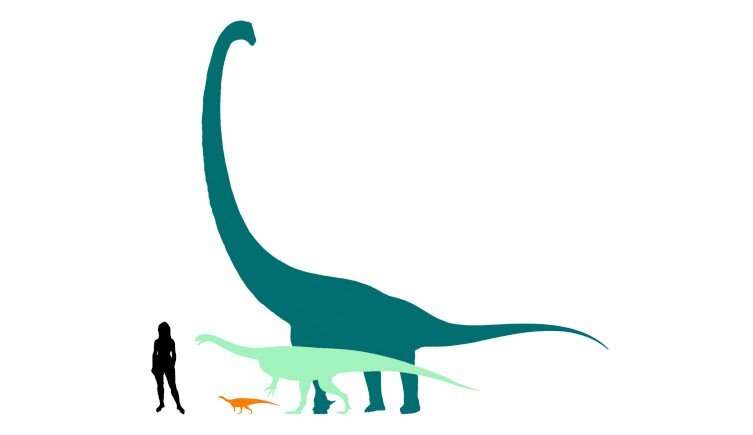This article has been reviewed according to Science X's editorial process and policies. Editors have highlighted the following attributes while ensuring the content's credibility:
fact-checked
peer-reviewed publication
trusted source
proofread
Fossil reveals smallest sauropodomorph dinosaur from the Jurassic

A tiny relative of titanosaurs has been uncovered in South Africa.
Weighing in at around 75 kilograms, the dinosaur would have barely been heavier than the average person. Its small size meant that for decades its sole fossil was thought to be the arm of a young Massospondylus.
New analysis, however, suggests this identification is mistaken. Its bone structure suggests that not only was the individual fully grown, but it probably comes from an entirely unknown species of dinosaur.
While there isn't enough evidence to name a new species yet, the fossil suggests that the ancestors of the sauropods and their close relatives, known as the sauropodomorphs, were more diverse than realized.
Dr. Kimberley Chapelle, the lead author of a new study on the bone, says, "Until now, we didn't know that early sauropodomorphs could get this small, so the smallest skeletons were assumed to be babies."
"We can now reassess these skeletons discovered in southern Africa and hopefully find a more complete individual from which we can name a new species."
The findings of the study were published in the journal Royal Society Open Science.
How was the smallest sauropodomorph discovered?
The fossil was first uncovered in 1978 in South Africa in rocks dating to the Lower Jurassic, which lasted from around 201–174 million years ago. The area it was discovered in is part of the Massospondylus Assemblage Zone, named for the dinosaurs which are commonly found there.

The abundance of these dinosaurs had been linked to the fallout from one of the largest extinctions of all time: the Triassic-Jurassic mass extinction event. It was thought that, with all the competition having been wiped out, these surviving dinosaurs were able to dominate the Early Jurassic ecosystems of what is now South Africa.
More recent research, however, has called this into question. In 2019, the authors of the new paper were among a team who realized that not all Massospondylus fossils were as they appeared.
"Massospondylus was first described in 1854 and was one of the first dinosaurs known from South Africa," Kimberley says. "At that time, there weren't many early sauropodomorphs to compare it to, and a formal description of this species' skeleton only came out in 2019."
"This meant, for a while, any early sauropodomorph found from the Early Jurassic in South Africa was referred to as Massospondylus."
This new assessment of Massospondylus resulted in some deformed bones being redescribed as belonging to an entirely new species of sauropodomorph now called Ngwevu intloko
But while describing Ngwevu, the team got the hunch that many other specimens in collections that have been identified as Massospondylus over the years may also be from other undescribed dinosaurs. It seemed likely that rather than a single species surviving and dominating in the aftermath of the Triassic-Jurassic extinction event, instead a whole host of sauropodomorphs flourished across southern Africa.
They've now proven themselves right while investigating a fossil humerus with the catchy name BP/1/4732.
What was the smallest sauropodomorph like?
While investigating how early sauropodomorphs grew, the team took small sections of bone from a variety of fossils. This revealed that their sample from BP/1/4732 was quite different from those of Massospondylus.

One prominent difference was the lines of arrested growth (LAGs), which look like tree rings in bone. They appear when growth slows down during, for example, the dry season and when a lot appear in close succession this is known as an external fundamental system (EFS).
"An EFS suggests an animal is done growing," Kimberley explains. "In Massospondylus, we've only seen an EFS in the bones of one individual, containing four LAGs. The arm bone we examined had 11 LAGs in its EFS, suggesting it was even more developed."
Comparisons of the size of the mystery arm bone to Massospondylus and other dinosaurs of a similar era reveal that it was much smaller than any of them. Only Adeopapposaurus had a smaller humerus circumference, but this fossil is thought to have been from a juvenile.
In fact, the new fossil is probably the smallest sauropodomorph of its era and may have been just a few meters long as an adult. While it's hard to tell much else from the arm bone alone, its shape suggests that the unknown dinosaur probably stood on two legs like its larger relatives.
Why more small sauropodomorphs didn't follow in its wake remains something of a mystery. It could simply be a result of preservation, or it may relate to the biology of the animal.
"Small ornithiscian dinosaurs like Lesothosaurus first appear in southern Africa during the Jurassic, and some scientists suggest they might have outcompeted early sauropodomorphs," Kimberley says.
"I think this is unlikely, as many similarly sized mammals share similar niches today. Instead, it's possible that sauropodomorphs lost the ability to stay this small as part of the evolution of large size, but we just don't know."
While this small dinosaur wouldn't live to see it, its distant relatives would go on to become the largest animals ever to walk the Earth as they flourished over the next 100 million years.
More information: Kimberley E. J. Chapelle et al, Osteohistology reveals the smallest adult Jurassic sauropodomorph, Royal Society Open Science (2023). DOI: 10.1098/rsos.221565
Journal information: Royal Society Open Science
Provided by Natural History Museum
This story is republished courtesy of Natural History Museum. Read the original story here.





















